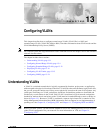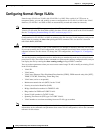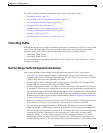
13-2
Catalyst 2950 Desktop Switch Software Configuration Guide
78-11380-05
Chapter 13 Configuring VLANs
Understanding VLANs
Figure 13-1 shows an example of VLANs segmented into logically defined networks.
Figure 13-1 VLANs as Logically Defined Networks
VLANs are often associated with IP subnetworks. For example, all the end stations in a particular IP
subnet belong to the same VLAN. Interface VLAN membership on the switch is assigned manually on
an interface-by-interface basis. When you assign switch interfaces to VLANs by using this method, it is
known as interface-based, or static, VLAN membership.
Supported VLANs
Catalyst 2950 switches that run the standard software image (SI) support 64 VLANs; switches that run
the enhanced software image (EI) support 250 VLANs. Refer to the release notes for the list of switches
that support each image. VLANs are identified with a number from 1 to 4094 when the EI is installed
and 1 to 1005 when the SI is installed. VLAN IDs 1002 through 1005 are reserved for Token Ring and
FDDI VLANs. VTP only learns normal-range VLANs, with VLAN IDs 1 to 1005; VLAN IDs greater
than 1005 are extended-range VLANs and are not stored in the VLAN database. The switch must be in
VTP transparent mode when you create VLAN IDs from 1006 to 4094.
The switch supports per-VLAN spanning tree (PVST) with a maximum of 64 spanning-tree instances.
One spanning-tree instance is allowed per VLAN. See the “Normal-Range VLAN Configuration
Guidelines” section on page 13-5 for more information about the number of spanning-tree instances and
the number of VLANs. The switch supports IEEE 802.1Q trunking for sending VLAN traffic over
Ethernet ports.
Floor 1
Floor 2
Engineering
VLAN
Cisco router
Fast
Ethernet
Floor 3
Marketing
VLAN
Accounting
VLAN
16751


















